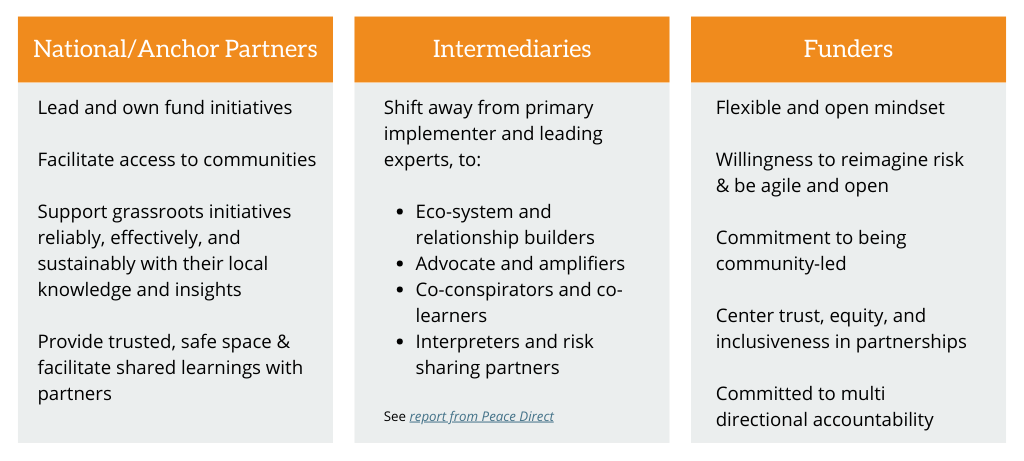To bring about real change in the aid and philanthropy sector, we must reimagine our roles in the ecosystem and support community organizations to lead.
The international development, philanthropy, and aid sectors are on a long overdue transformation journey. 2020 was a catalytic year with seismic events like the COVID-19 pandemic and the Black Lives Matter movement pushing toward more fundamental change. The consequence of these events reaffirmed what many already knew: that global structural power imbalances were not only unethical but also hindering the effectiveness and efficiency of durable and responsive societal change.
These moments provided real-time, powerful testaments to the world that communities are experts in their situations and are best placed to design and implement their own solutions. They are the first and last responders in any given crisis or emergency. Unlike international partners, community organizations and leaders cannot simply leave when a situation becomes challenging. By centering community organizations and leveraging their distinct advantages, the subsequent locally driven interventions and solutions are likely to be more responsive, equitable, contextually relevant, adoptable, and sustainable.
Despite global commitments, funding data is disappointingly trending backward, with only 1.2% of international humanitarian aid going to local NGOs in 2022; a far cry from the 25% committed by the Grand Bargain.
Now in 2023, how can the philanthropy and aid sectors facilitate transformative change in equitable, dignified, and impactful ways?
Change is hard. But for change to happen, we need to reimagine our roles in the aid and philanthropy ecosystem and make these changes urgently.
In 2021, a group of organizations with like-minded values created a consortium to pilot a new way of funding and partnering with the common goal of putting communities at the center of the work and equity at the center of our relationships. The consortium partners are the Center for Disaster Preparedness (CDP) Philippines, GlobalGiving, the Global Fund for Community Foundations, and the Nonprofit Finance Fund. Together, we launched the Assets, Agency & Trust initiative and supported the creation and implementation of the Abot-Kamay Community Solidarity Fund (ACSF), a locally led grantmaking mechanism.
CDP co-designed, fully managed, and implemented the ACSF, with strategic support from the consortium of global partners. The model demonstrates a locally led, innovative partnership approach aiming to reach marginalized communities often overlooked for or unable to access funding. The fund aimed to better understand the community-led change landscape in the Philippines, and to elevate, connect, and strengthen local ideas and efforts with a view toward long-term sustainability.
In practice, this means CDP took end-to-end ownership and leadership of the fund, informed by the community partners they work with. Every aspect was led by CDP’s knowledge and insights into the culture, context, and Filipino communities—from the design of the call for proposals to the community-centered grant selection process, due diligence, and monitoring and evaluation.
Of course, national funds are not unique. What we were able to achieve with ACSF was the ability to reach grassroots organizations that USAID (and GlobalGiving) would not be able to traditionally partner with or grant funding to due to vetting requirements, language, and digital capabilities. So a key benefit of this model is that it enabled USAID dollars to reach local communities and for those community organizations to determine the use of funds without outside bias or control.
What would we recommend to rebalance funding dynamics? A focused investment on regional or national ‘hubs’ that can house Community Solidarity Funds. These ‘anchor’ entities are safe, trusted, accessible, and effective at providing long-term support for community organizations. And they can support contextually appropriate practices to distribute funds.
A critical lesson from this initiative is that nothing will change if we do it alone, so we need to prioritize how we partner. We need to radically change our mindsets and our roles so that we can expand the reach of international funds to local experts and vulnerable communities.

We advocated for the national organization (CDP) to lead and host the funding mechanism (ACSF), given their expertise and connection to the communities and context. As the primary funding recipient, GlobalGiving acted as a bridge and supporter, identifying opportunities to innovate and remove barriers. We regularly communicated with the funder to build our collective understanding of what we wanted to achieve, and to examine how we would work within the funder’s requirements while centering a community-led approach. For example, we developed a grantmaking guide for ACSF hosted by CDP and worked with the funder to align our understanding and practices.
Our experience highlights how roles and mindsets need to shift to move decision-making closer to local communities.

We imagine that if all funders, international organizations, and national organizations could embody the roles outlined above, more equitable partnerships would flourish. This would lead to greater power and decision-making for and with communities around the world. If these models are more frequently adopted, we anticipate expanded impact and effectiveness, including an increase in:
Adopting new models and ways of doing, thinking, and being will need investment. It is important that actions now focus on these emergent models if we want to see these changes and stop current inequitable practices. We need investment to build a better system for all.
In our experience, community philanthropy and being community led is not an end goal. It is something to be practiced daily with intention, and a pathway to explore new ways of equitably partnering and embedding anti-racism in our daily work. With this initiative, we are continuing to lean into and interrogate what it means for us to better support community assets and agency, and how to center trust. Welcome to our learning journey.
Read more from the Assets, Agency & Trust Program.
Featured Photo: Mindanao Sanitation and Food Security Project by Asset-Based Community Development with Equity FoundationFind exactly what you're looking for in our Learn Library by searching for specific words or phrases related to the content you need.